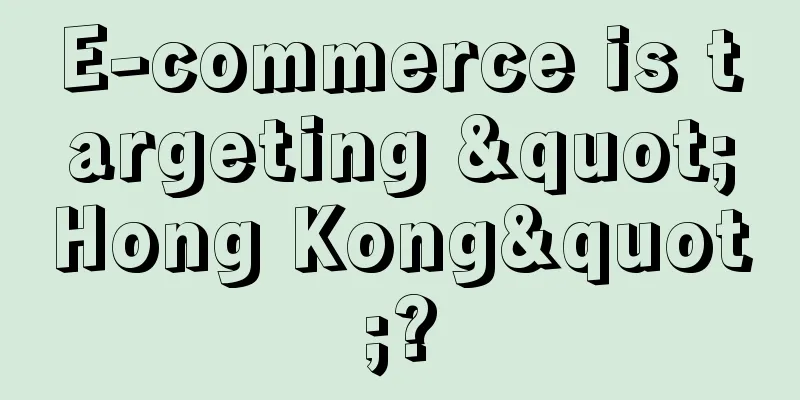How can small and medium-sized consumer brands catch up with the new offline hot battlefield?

We can directly feel that most of the consumer brands that were popular online before have now moved to the offline market. From the earliest beauty influencers Perfect Diary and Huaxizi, to the later new online forces in various industries such as Bananain, Ubras, and Wang Xiaolu. There is also Babycare, a brand favored by mothers, which has more than 30,000 stores in supermarkets alone.
1. Online shopping is really not that popular anymoreWu Xiaobo said before that the so-called new consumer forces may not have been in this industry. Because they mastered the traffic capacity, they achieved explosive growth in a very short period of time through traffic delivery and the boom period of e-commerce. In other words, the rise of most online brands comes from the founding team's manipulation of traffic. With the help of traffic dividends and capital dividends, new consumer forces are eager to run through a growth chain: Financing - investment - short-term explosion - user repurchase - decreasing marginal costs under economies of scale - profits covering costs - positive cash flow growth and self-circulation - getting rid of capital dependence. Why are the new consumer forces confident that they can succeed in this path? Because this path has worked well in other industries, especially in entertainment. The star-making path in the past basically continued the trilogy of "performing arts products - mass media attention - topic marketing". However, "Lu Hans" have greatly shortened the fermentation process. They first gather precise fans on social media, and their channels are Tieba, QQ groups, WeChat Moments, Weibo celebrity rankings, etc. After forming a considerable fan base, they then reversely detonate in the mass media. In the consumer sector, social media platforms such as Douyin, Xiaohongshu, and Bilibili have formed a traffic pool. Brands that were the first to speak out on these platforms, such as Perfect Diary, Wang Baobao, Ubras, etc., achieved maximum communication effectiveness at extremely low traffic costs. After launching its Douyin app, Wang Baobao, a health food brand that entered the cereal category in 2018, increased its monthly sales from 1.2 million yuan to 40 million yuan in just nine months. Ubras, a women's underwear brand founded in 2016, achieved an astonishing 800% year-on-year growth rate in 2020 after being put on the Douyin information flow. But starting in 2021, a large number of emerging brands saw the opportunity and flocked to Douyin and Xiaohongshu at the same time, and the traffic depression was quickly squeezed into a red ocean. In the first quarter of that year, many brand owners complained to me that their ROI dropped painfully. This is not the biggest problem. What’s even more annoying is that the customer traffic attracted at high cost does not actually bring ideal returns. Is this all due to the disappearance of traffic dividends? Of course not. First, the efficiency of user repurchase and bringing in new customers is low. Behind this problem is actually the problem of product homogeneity. Currently, most brands focus on the marketing end, while product research and development and even the entire supply chain construction are placed on mature processing plants. What is the problem? Multiple brands rely on the stock of a few processing plants, resulting in a large number of similar products flowing into the market. They are no different in function and quality, but just have different LOGO labels. When these brands are promoting online customer acquisition, users' choices are flexible. They do not have much stickiness to products of a similar brand, and of course there is not much word-of-mouth fission. Secondly, the brand’s multi-category products are not able to better absorb customer flow. This is directly related to the spread of new media channels, especially Douyin and Kuaishou, whose recommendation mechanism pushes information based on personalized interests, that is, interest-based e-commerce. Brands will create diverse content to promote their products based on different interests and scenarios. Users may be attracted by the content and pay for it in such scenarios. But he is not buying the brand, but the individual product itself. For example, after a beauty brand uses lipstick to do hobby e-commerce, it is actually difficult for its other products such as eye makeup and skin care products to gain monetization from this wave of traffic. Unless, the brand creates new interest content based on eye makeup to reach interested groups. In addition, more brands do not actually have enough SKUs to alleviate user churn. When people buy your product out of casual interest or the impulse of "trying something new", but you don't have more differentiated new products to reach users in the long term, this wave of users will be lost. In this way, brands need to continue to acquire customers at high costs and continue to accept the fact that the return on customer acquisition is low. In the end, brands are working for media platforms and KOLs. 2. There are indeed many temptations offlineFirst of all, in terms of sales, offline channels have certain advantages. The Taobao brand Three Squirrels proposed a plan to go offline very early. The boss Zhang Liaoyuan once explained the logic of going offline: First, although online virtual shelves can display enough products, users do not browse deeply enough. They usually only choose those popular products, that is, the best-selling products. Generally speaking, the profit of best-selling products is lower and it is not easy to make money. With the continuous increase of SKUs, even if the online virtual shelves can accommodate them, users may not be able to browse them all. Second, despite the fact that they are all creating the ultimate cost-effectiveness, the online environment has fostered a serious price comparison mentality. In this online environment, other low-priced products are also influencing user decisions, even if the price difference is only 0.01 yuan. Third, the express delivery costs of online consumption cannot be covered. High cost-performance ratio will trigger user consumption, but low customer unit price will inevitably increase the proportion of logistics costs. Fourth, the consumer experience is difficult to guarantee. For example, in the beauty industry, offline store makeup trials are the most common consumer scenario. After all, users can more intuitively access all SKU products offline, and the effect of low-gross-profit blockbuster products will be diluted; the experience will be improved, and consumption conversion will inevitably increase; the price comparison atmosphere will be diluted, and users do not have to bear the logistics costs... This is the common logic for all online consumer brands to go offline. Secondly, from a brand perspective, offline advertising has its own advertising effect. Some brands open large-scale experience stores offline, for example, Guanxia, a niche aromatherapy brand, opened its first store in the southwest of Chengdu on the 100-year-old Ancestral Hall Street. The building was the Sichuan Art Society during the Republic of China period and is a cultural relic protection unit in Chengdu. Large cultural stores like Guanxia can directly increase brand potential. Directly entering the shelves of terminal channels without opening a store is actually a form of brand placement. The shelves are the most intuitive advertising space, which can truly allow users to see, touch and buy. There is such a point of view in H&H's super symbol theory: use the shelves as advertising space. Finally, from the perspective of overall operations, the integration of online and offline operations has become a consensus . Since the new retail concept was proposed in 2016, the integration of online and offline has become a fact that all brands must plan for. Stores have their own traffic. Single stores cover a 3-kilometer radius, and large supermarkets cover a 10-kilometer radius. The offline influence of some celebrity supermarkets is even within the same city or across cities. The 10-kilometer scale effect is a normal value. Wei Zhe of Jiayu Fund once mentioned that once Walmart opened, no grass grew within 10 kilometers. In the same city or across cities, a representative case is Wanzhou Wanda. Wanzhou is a county more than 300 kilometers away from Chongqing. At that time, a secretary of the district found Wang Jianlin and hoped that he would invest in Wanda. At that time, Wanzhou had just been connected to the expressway, and the county town had a population of about 400,000. Wang Jianlin invested in Wanda out of consideration for poverty alleviation. Unexpectedly, the mall had a customer flow of 1.03 million in the first three days of its opening, setting a record for all Wanda opening customer flow. This kind of influence is cross-city. People from Liangping, Kaizhou, Yunyang, Fengjie and other counties and districts near Wanzhou will go to Wanzhou to visit Wanda during holidays. What I want to say is that such economies of scale are actually the empowerment of online traffic. Of course, offline traffic can also be fed back to online to form global customer assets . In the future, in-store and home delivery scenarios can be interwoven into a system based on the layout of global customer assets and offline terminal channels. 3. The unfamiliar offline world requires more detailsWhen you get down the line, the most important thing is to explore the passage. I visited several hidden champions in the industry in Shandong. They hardly made any brand investments, but their channels have been stable for more than 20 years. When a new product comes out, ask channel dealers to come to the company for a visit, or go to the markets of various channel dealers yourself. These people can be called brothers and sisters, so it is not easy to promote the product. Many of these dealers are family-owned dealers. Several generations or the entire family are in this business. A word from one person can make your product a hit in a certain area, or of course, can make your product no longer be on the shelf. There was also a pastry shop owner who was the first to take over fruit retail stores across the country and sell pastries in the fruit shops. The largest fruit dealer in Chongqing, the top three fruit owners in Guangzhou... Just communicate well with these people. Sitting together with dealer friends, chatting, drinking, chatting and swearing, this is friendship. There are actually very few new consumer forces born from the Internet. Previously, a distributor of Yuanqi Forest said that Tang Binsen did not seem like one of their own, he was tall, noble, clean and decent. Yuanqi Forest was originally founded by an Internet team. But later, when the growth rate slowed down, Tang Binsen also realized that what was established with dealers and suppliers was not just a business relationship, but a deep partnership based on shared experience and trust. He emphasized that joint efforts and trust were the key to maintaining such a relationship amid market fluctuations and challenges. After that, Tang also began to visit dealers in various places. In addition to activating and clearing sales channels, all consumer products should truly treat shelves as advertising spaces, which is what they should carefully polish. When your product is on the shelf, according to the consumer's purchasing journey, can he see it, be willing to take it, get it, and buy it? First of all, it is about display. For example, more products should be displayed in the middle of the shelf so that users can see them at eye level. If they are too high, it is difficult to reach them, and if they are too low, users need to bend down. Of course, there are exceptions. For example, 5L and 10L large barrels of drinking water, cooking oil, and even 2L drinks such as Coke and Sprite with pull rings are scattered on the ground, which is easier to generate transactions. How to place large bottles of Coca-Cola to double the sales? Finally, it was found that if the front-line staff placed the large bottles of Coca-Cola on the ground, and not too neatly, but scattered crookedly, it would double the sales compared to placing them on the shelves. Why is this? Xiao Ma Song explained, A large bottle of Coke is heavier, so it is easier to lift if placed on the ground; in addition, if it is placed crookedly on the ground, like a street stall, it makes the bottle look cheap. In addition to display, the product itself must serve as a medium to attract consumers. First of all, color is the most important thing, it can attract users to come to you. Many friends know this, the same color, similar color, gradient color, complementary color, contrasting color, and collision color, whatever arrangement looks good. But it should be emphasized that the content of offline product display should start from the product packaging design. For example, on the coffee shelf with brown as the main color, Sumida River uses a brighter red to attract attention. I heard from a former executive of Nongfu Spring that in order to stand out among similar products, Zhong Shanshan, against all odds, changed the outer packaging of Nongfu Spring to red. In design, in addition to color, style is also important. For example, ready-to-drink coffee brand Benejoy has introduced a new bottle shape and new packaging with simple lines to stand out on the shelf. In winter, Benejoy even put a woolen hat on the bottle cap. There is also a science to attracting attention and boosting sales conversion. When we interviewed the founding team of Yungengwuzuo before, we had a discussion about the brand's packaging content upgrade. In the brown sugar industry, it is actually more about categories than brands, so the first problem you need to solve is to tell users that the brown sugar they are looking for is here. In terms of packaging, Yun Gengwuzuo’s brand name is not very big, and the core content is what it sells: “brown sugar ginger tea”. Secondly, users will ask, why should I buy your brown sugar instead of others? This actually solves the problem of the core selling point. Therefore, there is a big "warm" character on the packaging of Yungengwu. This corresponds to the largest consumption scenario of brown sugar, which warms the stomach of women during menstruation. The super symbol of the word "warm" has a cognitive impact at the system level. Other information presented includes the story of Zhong Xiaoyu dropping out of Peking University to find the best brown sugar ginger tea for her lover, as well as the three-dimensional creation of users' trust in "Nuan" from aspects such as ingredients and production process. In the end, by upgrading the content on the packaging, Yun Gengwu’s sales doubled and became the number one in the brown sugar category on Tmall. Offline shelves are the closest place to brands for users, and the place where they can get to know brands the best. This requires brands to pay enough attention to details and polish the content in a scenario-based way by standing in the shoes of users. Author: Huang Xiaojun; Official Account: Jingyan Brand Lab (ID: JingyanLab) |
<<: Cadillac's new car pre-release poster sparks controversy: Coconut tree style mocked by netizens
>>: Xiaomi SU7 is a hot seller, why do people think it is great value for money?
Recommend
How to reduce the weight of short video editing and secondary creation?
Secondary creation can give new life to the origin...
What are the four matching methods of Amazon manual advertising? What are their characteristics?
When you place ads on Amazon, many people will cho...
Challenging L'Oreal, PROYA suffers from marketing difficulties
In recent years, in the process of challenging int...
What should I do if my Meikeduo store is closed? How should I choose products?
After you open a store on the Meikeduo platform, i...
How to place Amazon video ads? What are the strategies?
No matter which platform you open a store on, as l...
Is it useful to promote products outside of Amazon after the new product period? When is the best time to promote products?
There are many merchants doing business on Amazon ...
New opportunities emerge, a comprehensive review of data career development paths
In the data-driven era, data analysis has become a...
Wish will launch the "Everyday Black Friday" promotion
Wish merchant platform announced that Wish will la...
Top anchors turn to short dramas to create the myth of selling goods again?
Hansu achieved sales growth through short drama ma...
Douyin is making efforts in the same city, and Meituan should be anxious
This article discusses the competitive relationshi...
ChatGPT + Xiaohongshu popular article, mass production of 100 notes in 1 day
How can we use ChatGPT for content marketing on a ...
What should you pay attention to when following others on Amazon?
The advantage of Amazon follow-selling is that upl...
How to grow private domain activities like a "big company"
To achieve growth, you need not only a global pers...
The secret to Xiaohongshu's hit articles | Case analysis of the hottest notes in January
How to create a hit is still a headache for many X...
4 Ways to Achieve Financial Freedom
Everyone yearns for financial freedom, which suppo...









